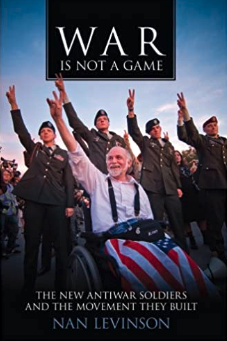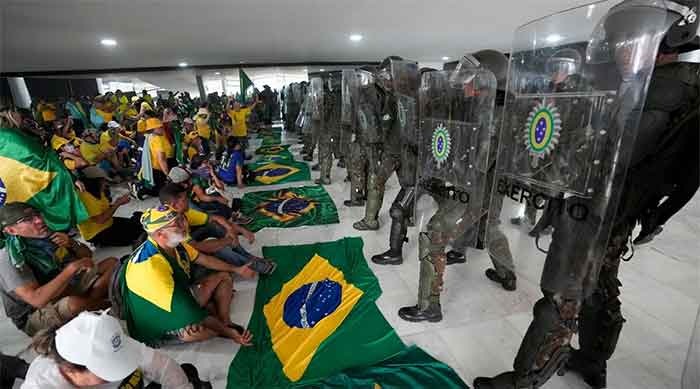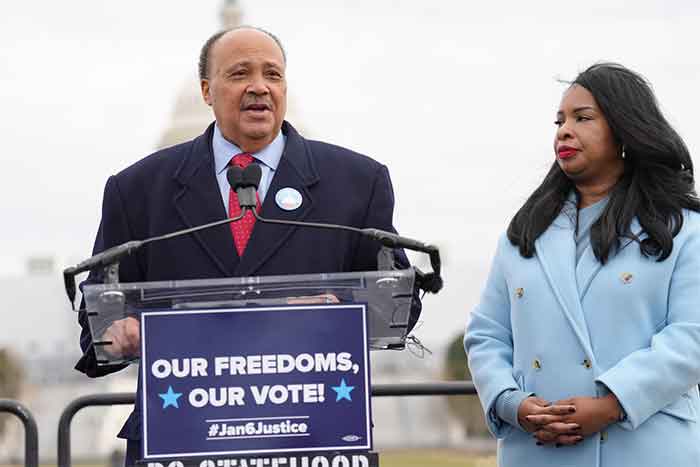
It was around noon and I was texting a friend about who-knows-what when I added, almost as an afterthought: “tho they seem to be invading the Capitol at the mo.” I wasn’t faintly as blasé as that may sound on January 6th, especially when it became ever clearer who “they” were and what they were doing. Five people would die due to that assault on the Capitol building, including a police officer, and two more would commit suicide in the wake of the event. One hundred forty police would be wounded (lost eye, heart attack, cracked ribs, smashed spinal disks, concussions) and the collateral damage would be hard even to tote up.
I’m not particularly sentimental about anyone-can-grow-up-to-be-president and all that — in 2017, anyone did — but damn! This was democracy under actual, not rhetorical, attack.
As the list of people charged in connection with that insurrection rose, ways of analyzing their possible motivations grew ever more creative: at least nine of the rioters who broke into the Capitol had a history of violence against women; almost 60% had had money troubles; and above all, 50, or 14.5%, of the 356 people arrested at last count, had military connections, as did the woman killed by a policeman that day. (Veterans and active-duty personnel account for 7.5% of the U.S. population.) More than a fifth of the arrested veterans have been charged with “conspiracy.”
The need to understand why an estimated 800 people ransacked the Capitol, attacked the police, and threatened elected representatives, journalists, and the basic functioning of American democracy is both practical and emotional. Thinking that we know what motivated the rioters makes their rebellion feel a little more manageable (at least to me) and might just help prevent something like it from happening again.
Given my background — I’ve been writing about soldiers and veterans for years — my management technique has been to look at the military links to that assault.
I’m hardly alone. In one of the few times other than Veterans Day in this century when American journalists seem to have remembered that our military was crucial to our national experience, a number of them began covering that link. A regularly updated NPR list shows that almost all of those with military affiliations in the Capitol that day were veterans. Several had previously been deployed to Iraq or Afghanistan; one had worked on presidential helicopters and so (like another of the rioters) would have had a top-secret security clearance; one, who wasn’t actually at the Capitol but whom the FBI is eyeing for conspiracy charges, was on the staff of former congressman Ron Paul; and one had even been in the Peace Corps. Nearly all of them were men and nearly all were white. Two were Citadel cadets, but only two were active-duty personnel. (One of those had, in the past, come to work at a Navy yard in New Jersey decked out in a Hitler mustache and hairdo and reportedly made anti-Semitic comments daily. He got admonished for the mustache; the comments continued.)
I admit that I was surprised by all this, although I probably shouldn’t have been. After all, last year, even in the age of Trump, the FBI had opened 68 investigations into domestic extremism involving current or former members of the military.
I’m sure you won’t be surprised to hear that many of those veterans were affiliated with the far-right Proud Boys or Oath Keepers and much has been made of why such groups would want to engage people with military experience who bring with them training, skills, possible access to weaponry, and the twisted credibility of government-issued hero status. Far less was said about why people in the military might be attracted to far-right groups.
The Link Between Extremist Culture and the Military
A week after the Capitol invasion, 14 Democratic senators wrote a letter calling on the Pentagon’s Inspector General to investigate “white supremacy” and “extremism in the military.” The next month, a House subcommittee held a hearing under the rubric “Alarming Incidents of White Supremacy in the Military — How to Stop It?” Meanwhile, on February 5th, the first Black secretary of defense, Lloyd Austin, directed commanding officers at all levels to conduct a one-day stand-down before April 1st to address extremism in the military and provide training in avoiding involvement with extremist groups. At the same time, the Pentagon admitted that it didn’t have a handle on the scope of the problem or what to do about it.
The link between extremist culture and the military goes way back, as do efforts to track and deal with it. The names of the groups have changed over the years — they used to sound German, now they sound moralistic — but the problem hasn’t. For instance, in 2009, Operation Vigilant Eagle, an FBI program focused on the recruitment of veterans by white supremacist groups, came to light, and that same year a Department of Homeland Security assessment warned that “right-wing extremists will attempt to recruit and radicalize returning veterans” — returning, that is, from America’s distant, never-ending wars. Conservative politicians, media personalities and veterans’ groups found that DHS report insulting to veterans and got it withdrawn.
Keep in mind that active-duty service members are officially restricted in their political activities, so there were undoubtedly many still in uniform who didn’t show up at the Capitol but would have liked to do so. And though the Proud Boys have focused their recruiting on the military and law enforcement, it’s hardly necessary to join such loosely structured groups to support their ideology and aims. A 2019 Military Times survey, for example, found that 36% of military respondents had “witnessed examples of white supremacy and racist ideologies” in the ranks.
Military rules tend to delineate the rights soldiers don’t have more than those they do, but Department of Defense Directive 1325.6 gives active-duty members the right to participate in political demonstrations as long as they are off base, out of uniform, within the United States, representing only themselves, and not slandering the president or high officials. However, activities like fundraising for, distributing the political material of, or wearing the totemic clothing of white supremist and other extremist groups could indeed get you kicked out of the military, as could certain kinds of social-media posts.
Congresswoman Jackie Speier (D-CA) has been pushing to track the social media activities of all enlistees and the Pentagon claims that it’s looking for a “scalable way” to add that into background checks.
Members of the armed forces have a duty to report such behavior, though don’t count on that, since it’s probably seen as snitching. Commanders also have considerable leeway when it comes to how they might respond to the proscribed actions.
It goes without saying, of course, that soldiers are not supposed to engage in any kind of violence — except the violence they’re ordered to take part in as soldiers.
That’s Not Okay — ish
America’s military was designed to be politically neutral and has prided itself on being nondiscriminatory and merit-based, traits theoretically crucial to maintaining an all-volunteer force (though in racial terms over the years it’s been anything but, at least when it came to the high command). All branches now purport to screen for supremacist, extremist, or criminal-gang involvement at the time of enlistment and military leaders, who probably don’t want troublemakers in their commands, are reportedly taking pains to confirm that such extremists will not be tolerated.
Except when they are.
The design of military justice makes it hard to track advocates of extremist violence, as there is no centralized record-keeping for such things and, often enough, such behavior is simply brushed aside.
In my own unscientific survey, I recently asked two active-duty soldiers and three Iraq War veterans if they had encountered right-wing extremism while in the service. Four initially said no — the fifth, a Black sailor, at one point had had a noose dangled in his face — but then began recounting tales of what was permitted or considered normal behavior: a U.S.-based paramedic talking about avoiding a Black neighborhood where he would encounter “animals”; a call from a friend and Stryker platoon leader in Germany who found arbeit macht frei, the slogan at the gates of the Nazi concentration camp at Auschwitz, carved into the interior of some of his unit’s vehicles; a fellow recruit at basic training revealing a giant swastika on his back. He was soon sent packing, but had made it through the enlistment process where such things are supposed to be caught. (My source thought his quick dismissal came only because his training instructor was Black. He didn’t consider such a response typical.)
Nobody I talked to was okay with any of this, but one active-duty soldier admitted, “When I was most brainwashed, I saw it as cathartic, being comfortable without having to worry about ‘cancel culture.’”
Extremism in a World of Never-Ending War
Organizing within the military isn’t easy. At least, it wasn’t for antiwar activists during the Vietnam and Iraq War years (as I found out when researching my book, War Is Not a Game: The New Antiwar Soldiers and the Movement They Built). But maybe what’s going on now among the soldiers of the far right isn’t organizing as much as a signaling or sharing of interests and affinities, particularly on the Internet. Or maybe it’s “self-radicalizing” — reading extremist material, following the websites of supremacist groups, or connecting on social media; what, in other circumstances, we might call educating yourself — which breeds sympathy, if not membership.
As separate as the military may seem from civilian culture, it’s anything but immune to the vicious discord which now plagues this country. But the military was fertile territory for right-wing sympathies long before Donald Trump became president or the Proud Boys and Oath Keepers came along. The turning of the post-Vietnam War military into an all-volunteer force only seems to have exacerbated such tendencies. As an Army captain emailed me, “The military recruits heavily from the same population that extremist organizations do — socially isolated, downwardly mobile, and economically vulnerable young men.” Jonathan Hutto, a Black veteran who challenged the racism he encountered in the Navy, wrote that his shipmates didn’t need to be “inculcated with Racist-Fascist Ideology” because they had arrived primed for it by their families and communities.
A former captain in the Marines told me that veterans often find themselves battling with the VA over benefits and services they thought they’d been promised when they went to war and that leaves them embittered against the government. Their difficulty in even talking honestly about their war experiences, not to speak of the PTSD they may be experiencing, often leaves them feeling out of sync with the country — and so they become ready recruits for extremist and white supremacist groups that offer them a sense of belonging.
Active-duty service members also often feel betrayed by recruitment promises which never pan out and multiple deployments in distant war zones which accomplish little or nothing at all. Speaking of that sense of resentment, Garett Reppenhagen, executive director of Veterans For Peace, says, “They just can’t pinpoint where it comes from. The frustration is legitimate. It’s just focused wrongly.”
Kathleen Belew, a historian much cited in the wake of the January 6th insurrection, studied the appeal to veterans of white-power groups in the aftermath of the Vietnam War. In her book Bring the War Home, she explains how they came to see the state as the enemy and patriotism as something other than defending the nation. The parallels to today, while striking, lack one reality of this moment: unlike in the Vietnam era, America’s wars in this century have simply never ended and so continue to produce alienated veterans.
It’s striking, after all, that the veterans who joined the Capitol insurrection weren’t exactly kids. In fact, only seven military-connected rioters arrested so far are 30 or younger.
Unlike with Vietnam (long as it was), when wars never end but continue, as if on a Mobius strip of belligerency and repetitious deployments, there is no aftermath, no recovery. People now old enough to enlist have never known a United States not at war. As a result, the pressures now at play and producing extremism in the military could be seen as related to what one veteran I interviewed termed a larger “cultural project” that, however unexamined, is aimed at creating an ever-more-militarized (which also means an ever-more-extreme) society.
Here, war is sold, not just as acceptable, but as necessary to maintain the vaunted American way of life. Meanwhile, its actualities are largely cloaked from scrutiny until they shimmer into a very pricey item loved by both parties. It’s called the Pentagon budget.
An Increasingly Militarized Heritage
However many military-related figures broke into the Capitol on January 6th, what if the tendency toward violent extremism is more endemic to that military than we’d like to think? What if the very purpose of such a military creates the conditions for the racism and violence we’re now seeing? What if far-right radicals aren’t some enemy out there but a seamless outgrowth of the institution we think of as so categorically American? And if all that’s so, what have we really been thanking service members for, so devotedly all these years?
A military is, of course, innately hierarchical, authoritarian, and adversarial, and war, by definition, is terror. Tenets inculcated from basic training on — venerating tradition, idealizing heroism, valuing action for action’s sake, equating masculinity with militarism, and thinking of anyone who disagrees with you as potentially treasonous — are eerily similar to the ideology of far-right groups. And don’t forget this either: American wars of the past 70 years have functioned by reducing the enemy to gooks, sand n***s, and hajis (the last, a term of respect in Islam twisted into an epithet by American troops) — in other words, using baked-in racism to dehumanize enemies and make it easier to hate and kill them.
Don’t misunderstand me. I’m by no means saying that everyone in the U.S. military is racist or enamored of violence, or that they condone or support racist, violent ideologies. What’s true, however, is that the military’s actions are based on dividing the world into friends and foes: the first to be protected out of all proportion to the threat, the second to be humiliated and defeated out of all proportion to the need — though, in this century, ironically enough, the defeated have turned out to be us.
Such overkill in attitude and approach naturally bleeds into society as a whole (even when its members are paying remarkably little attention to the wars being fought in distant lands). Of his country’s treatment of Palestinians, the Israeli novelist David Grossman wrote, “I could not understand how an entire nation like mine, an enlightened nation by all accounts, is able to train itself to live as a conqueror without making its own life wretched.”
Only a small crew of people in the military actually join radical right-wing groups and there’s little question that its leadership is concerned about those who do. But there is an inheritance of violence in our increasingly militarized land that ought to concern us all, too.
Follow TomDispatch on Twitter and join us on Facebook. Check out the newest Dispatch Books, John Feffer’s new dystopian novel Frostlands (the second in the Splinterlands series), Beverly Gologorsky’s novel Every Body Has a Story, and Tom Engelhardt’s A Nation Unmade by War, as well as Alfred McCoy’s In the Shadows of the American Century: The Rise and Decline of U.S. Global Power and John Dower’s The Violent American Century: War and Terror Since World War II.
















































